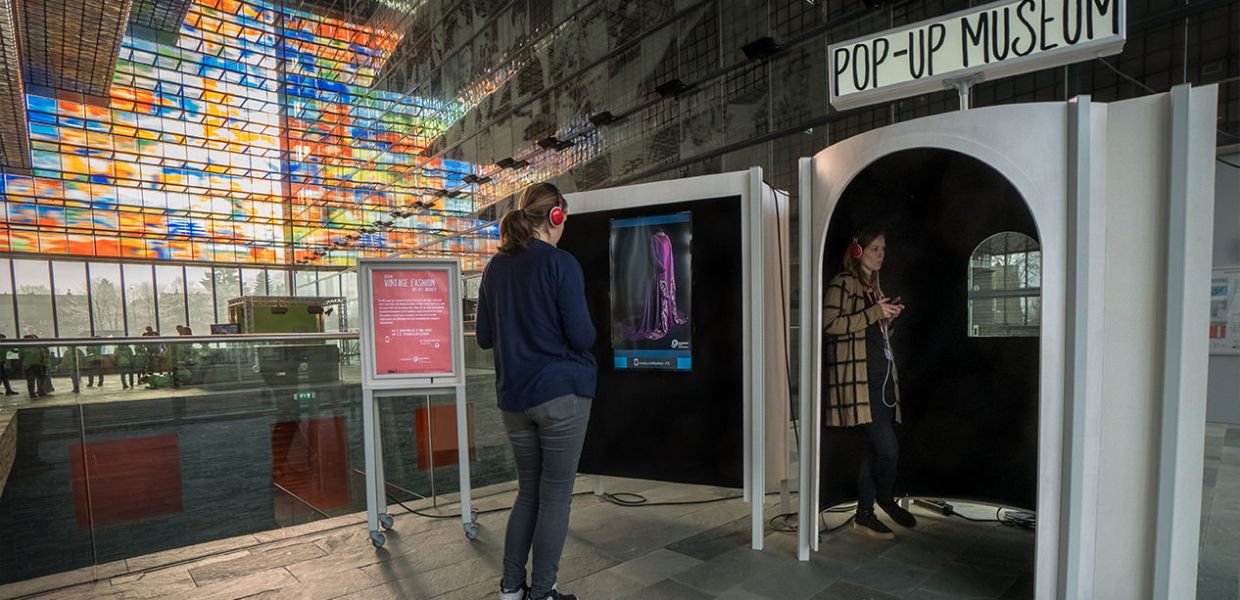MuPoP introduces Pop-up museums as an outcome of Europeana Space

Low-cost, high flexibility and transportable exhibitions are an up-and-coming tool for heritage institutions who wish to present their collections outside to new audiences. But they often come at a steep price or lack the control and engagement that works within the walls of an institution. As an outcome of Europeana Space, the three year EU-funded project aiming at catalyse the re-use of digital cultural heritage materials and pursue new business models, partners Noterik, iMinds, Netherlands Institute for Sound and Vision, Fondazione Sistema Toscana, KU Leuven and more banded together to merge their learnings and developments. The result is MuPoP, a new breed of pop-up museums.
MuPoP aims to create the technical and material space to foster re-use of cultural heritage in a new and innovative way. A hybrid of both a digital and physical museum exhibition, MuPoP is a way to showcase many of the prototypical ideas that have resulted from the pilot projects developed during Europeana Space, including interactive TV, photography, games, dance and hybrid publishing.
Learning from current trends
The key values of MuPoP are mobilisation, customization and ease of use. Cost for space rental, billboards or customised tech can be a severe barrier of access for institutions aiming to present their collection outside their walls.Years ago, the situation was very similar when presenting high quality curated content on the web. But with the introduction of free and open source services such as Omeka, Timeline.js and the Google Cultural Institute, organisations now have numerous low-cost options that previously were only available to the major players.
Equally, the more recent International Image Interoperability Framework is creating standards and tools simplifying web presentation and transfer of images plus enrichments; while Wikimedia Commons, Europeana and the Internet Archive offer a free place where institutes can share their open collections with tens of millions of users.
Furthermore, Content Management Systems like SquareSpace and WordPress have made it easier than ever to create a website to share ideas and build a community.
Keep it simple
Embracing these trends while innovating new ways to use public and open spaces, MuPoP has succeeded in offering an ideal service for any institution, of any technical competence, and any size. The strength comes from using the incredibly powerful tool most users have in their pocket a smartphone, an inexpensive HDMI stick computer, and several TV screens with HDMI capabilities.
Lastly, one of the main issues about museum apps is about convincing users to download it. QR codes can be burdensome, and renting a device from the museum is perhaps out of the price range for some visitors. To avoid these questions and get the users engaged right away, MuPoP uses HTML5 and a web browser turning the user’s smartphone into a remote control by typing in a simple URL.
MuPoP has already been used four times for four curations (Belle Époque: “Man meets world” Europeana Fashion, Dutch State Mines, and Hieronymus Bosch) in five different locations across Europe, with more to come. For those looking for the complete package deal, the Netherlands Institute for Sound and Vision has commissioned a fantastic housing unit specifically for MuPoP that can be easily transported.
Are you an insitute interesting in using MuPoP and taking your collection to the people? Contact the Netherlands Institute for Sound and Vision and Noterik at www.mupop.net
Would you like to get hands on with MuPoP? Sound and Vision will be demoing the installation at the Museum and the Web Conference on 19-22 April, in Cleveland, Ohioso be sure to swing by if you're in attendance!

